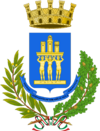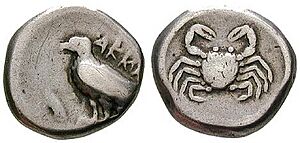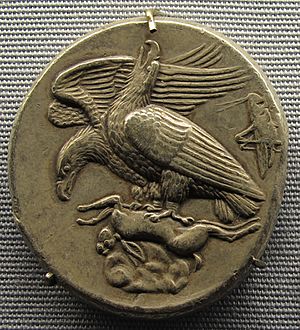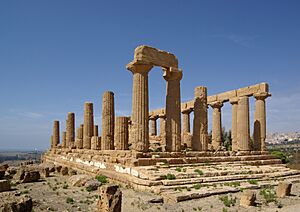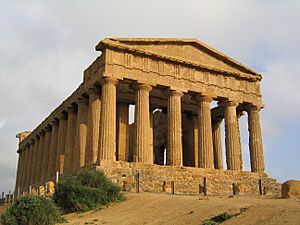Agrigento facts for kids
Quick facts for kids
Agrigento
|
|||
|---|---|---|---|
| Comune di Agrigento | |||
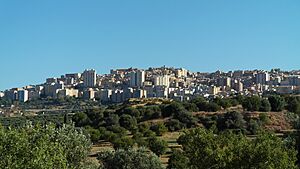
Agrigento skyline
|
|||
|
|||
| Motto(s):
Signat Agrigentum mirabilis aula gigantum
|
|||
| Country | Italy | ||
| Region | Sicily | ||
| Province | Agrigento (AG) | ||
| Frazioni | Fontanelle, Giardina Gallotti, Monserrato, Montaperto, San Leone, Villaggio La Loggia, Villaggio Mosè, Villaggio Peruzzo, Villaseta | ||
| Area | |||
| • Total | 245.32 km2 (94.72 sq mi) | ||
| Elevation | 230 m (750 ft) | ||
| Population
(31 March 2016)
|
|||
| • Total | 59,791 | ||
| • Density | 243.727/km2 (631.249/sq mi) | ||
| Time zone | UTC+1 (CET) | ||
| • Summer (DST) | UTC+2 (CEST) | ||
| Postal code |
92100
|
||
| Dialing code | 0922 | ||
| Patron saint | St. Gerland (Gerlando) | ||
| Saint day | 25 February | ||
Agrigento is a city located on the southern coast of Sicily, Italy. It is the capital of the Province of Agrigento.
The city was founded around 582 BC by Greek colonists from Gela. Back then, it was known as Akragas. It became one of the most important cities during the golden age of Ancient Greece. Akragas grew strong under the leader Theron in the 5th century BC. Many impressive public buildings and famous temples were built during his time.
Agrigento remained important even after the Punic Wars, becoming one of Sicily's largest cities during the Roman Republic era. Its port and different businesses, like sulfur mining, trade, and farming, kept it strong. The city continued to do well economically until the 7th century AD.
Contents
History of Agrigento
Early Greek Settlement
Akragas was built on a high area overlooking the sea. Two rivers, the Hypsas and the Acragas, flowed nearby. The city was named after the Acragas river. A natural ridge helped protect the city. It was founded around 582-580 BC by Greek settlers from Gela in eastern Sicily. More settlers came from Crete and Rhodes. The first leaders of the new city were Aristonous and Pystilus. Akragas was the last major Greek colony to be founded in Sicily.
Growing Power and Wealth
Akragas quickly grew its territory, covering the area between the Platani and the Salso rivers. It also reached deep into Sicily's inner lands. This growth happened over a long time, reaching its peak in the early 5th century BC. Other Greek settlements in Sicily also expanded during this period.
Archaeological finds show that local Sican people in this region started adopting Greek culture. This expansion gave Greek settlers more land to farm and access to native workers. It also gave Akragas control of a key land route to Himera on Sicily's northern coast. This route was very important for trade. It helped Akragas become very wealthy in the 6th and 5th centuries BC. People even said that the city's wealth was legendary. Around 520 BC, Akragas was one of the first cities in Sicily to make its own coins.
Around 570 BC, a leader named Phalaris took control of the city. He was known as a very strict ruler. He ruled until about 550 BC. Later, Akragas expanded west, leading to competition with Selinus, another Greek city. Akragas eventually took control of Heraclea Minoa around 500 BC.
The Time of Theron
Theron, from the Emmenid family, became the ruler of Akragas around 488 BC. He made an alliance with Gelon, the ruler of Gela and Syracuse. Around 483 BC, Theron attacked and took over Himera. The ruler of Himera asked the Carthaginians for help. The Carthaginians invaded in 480 BC, starting the first Greco-Punic Wars. However, Theron and Gelon's combined forces defeated them at the Battle of Himera.
After this victory, Akragas controlled a large part of central Sicily. Many huge building projects began in the Valle dei Templi (Valley of the Temples) during this time. These included the Temple of Olympian Zeus, one of the biggest Greek temples ever built. A massive water reservoir called Kolymbethra was also constructed. It is believed that war prisoners were used as workers for these projects. The city walls were also rebuilt on a grand scale. Theron also sent teams to compete in the Olympic games in mainland Greece. After Theron's death in 472 BC, his son Thrasydaeus took over. He was known for being harsh. Soon after, Hiero I of Syracuse overthrew Thrasydaeus. Akragas then became a democracy, though noble families still held much power.
Later Greek and Roman Times
The time after Theron's family lost power is not well-known. For a few years, a group of wealthy families called "the thousand" ruled. They were later overthrown. In 451 BC, Ducetius, a leader of the local Sicel people, attacked Akragas's territory. The Syracusans defeated Ducetius. The people of Akragas were upset by this and went to war with Syracuse. They lost a battle on the Salso river, making Syracuse the main power in eastern Sicily. This defeat was so serious that Akragas stopped making its own coins for several years.
Ancient writers said Akragas was a very large city. Some said it had 200,000 people, but modern experts think the population was closer to 30,000-40,000 people.
When Athens attacked Syracuse from 415 to 413 BC, Akragas stayed neutral. However, the city was later attacked and damaged by the Carthaginians in 406 BC. Akragas never fully regained its old glory, but it did recover after Timoleon's invasion in the late 4th century BC. Many new buildings were constructed during this Hellenistic period. In the early 3rd century BC, a ruler named Phintias declared himself king of Akragas and other cities, but his rule did not last long.
Roman Rule
The city was fought over by the Romans and the Carthaginians during the First Punic War. The Romans attacked the city in 262 BC and captured it in 261 BC. They sold many of the people into slavery. The Carthaginians took the city back in 255 BC, but the final peace agreement gave Akragas to Rome. The Romans renamed it Agrigentum. Even though it was under Roman rule, people there mostly spoke Greek for many centuries.
Agrigentum became rich again under Roman rule. In the 2nd century BC, the Roman general Scipio Africanus Minor gave the city a statue of Apollo. This showed their alliance during the Third Punic War.
The Roman writer Cicero noted that Agrigentum was an important city. He said it had a key port and was a center for Roman government. Many Roman citizens lived there peacefully with the Greek people, likely involved in trade. The city's people received full Roman citizenship after Julius Caesar died in 44 BC. Later, the city was given the special status of a Roman colony by Emperor Septimius Severus and was renamed "Colonia Septimia Augusta Agrigentorum."
A Christian community lived in the city until late Roman times. However, there was less activity in the city after the 7th century, possibly because trade routes were disrupted after the Arab conquest of Carthage in AD 698.
Middle Ages
After the fall of the Western Roman Empire, Agrigentum was ruled by different groups, including the Vandalic Kingdom, the Ostrogothic Kingdom, and then the Byzantine Empire. During this time, people moved from the lower parts of the city to the higher hill, which was the old acropolis. This move might have been because of attacks by the Saracens and other groups from the coast. In 828 AD, the Saracens captured the city. The Arabic name for it became Kirkant or Jirjant.
After the Normans conquered Sicily, the city's name changed to the Norman version, Girgenti. In 1087, Count Roger I set up a Latin bishopric in the city. The Normans also built the Castello di Agrigento to control the area. The population of the city went down during much of the Middle Ages but started to grow again after the 18th century.
Modern Times
In 1860, the people of Sicily, including Agrigento, supported Giuseppe Garibaldi during the Expedition of the Thousand. This event helped unite Italy and ended the rule of the Bourbon family. In 1927, Benito Mussolini changed the city's name to the current Italian version, "Agrigento." This decision is still seen as controversial by some, as it was a symbol of Fascism and changing local history. In 2016, the historic city center was renamed "Girgenti," using the old Sicilian name. The city was bombed several times during World War II.
Economy of Agrigento
Agrigento is a major place for tourists because of its amazing ancient ruins. It is also a farming center for the area around it. Sulphur and potash were mined here from ancient times until the 1970s. They were shipped all over the world from the nearby port of Porto Empedocle. In 2010, the number of people without jobs in Agrigento was 19.2%, which was almost double the national average in Italy.
Main Sights to See
Ancient Akragas covers a very large area. Much of it is still waiting to be explored. The most famous part is the Valle dei Templi ("Valley of the Temples"). This name is a bit misleading because it's actually a ridge, not a valley. This area has a large sacred space on the south side of the old city. Here, seven huge Greek temples were built in the Doric style during the 6th and 5th centuries BC. These temples have been dug up and partly fixed. They are some of the biggest and best-preserved ancient Greek buildings outside of Greece. They are listed as a World Heritage Site.
The best-preserved temples are two very similar buildings. They are traditionally linked to the goddesses Hera and Concordia, though we don't have proof of this. The Temple of Concordia is amazingly complete because it was turned into a Christian church in 597 AD. Both temples were built with columns all around. The area around the Temple of Concordia was later used by early Christians as a catacomb, with tombs carved into the rocky cliffs.
The other temples are much more broken. They fell down in earthquakes long ago, and their stones were used for other buildings. The biggest one is the Temple of Olympian Zeus. It was built to remember the Battle of Himera in 480 BC. It is thought to have been the largest Doric temple ever built. It seems it was never fully finished, and construction stopped after the Carthaginian invasion in 406 BC. Many of its stones were used in the 18th century to build the piers of Porto Empedocle. Temples for Hephaestus, Heracles, and Asclepius were also built in the sacred area. This area also has a sanctuary for Demeter and Persephone. You can still see marks from the fires set by the Carthaginians in 406 BC on the stones of the sanctuary.
Many other old Greek and Roman sites can be found in and around Agrigento. These include a very old cave sanctuary near a Temple of Demeter, where the Church of San Biagio was later built. A monument called the "Tomb of Theron" (though it's not actually his tomb) is just outside the sacred area. A shrine from the 1st century AD is next to the 13th-century Church of San Nicola. A large part of the Greco-Roman city has also been dug up. You can also see several old burial grounds and quarries.
Much of today's Agrigento is modern, but it still has many medieval and Baroque buildings. These include the 14th-century cathedral and the 13th-century Church of Santa Maria dei Greci ("St. Mary of the Greeks"). This church stands on the site of an ancient Greek temple, which is why it has its name. The town also has an important archaeological museum with items found from the ancient city.
Famous People from Agrigento
- Empedocles (5th century BC), an Ancient Greek pre-Socratic philosopher, was from ancient Akragas.
- Tellias of Akragas was known for being very welcoming.
- Karkinos of Akragas was a writer of tragedies.
- Tigellinus (born around AD 10), a leader of the Praetorian Guard and a friend of Emperor Nero, came from a Greek family in Agrigento.
- Faraj ben Salim (13th century), a Jewish doctor and translator for Charles I of Anjou.
- Paolo Girgenti (1767–1815), a painter who was born in Agrigento.
- Luigi Pirandello (1867–1936), a famous writer and Nobel prize winner for literature, was born in Agrigento.
- Giovanni Leone (born 1967), an Italian scientist who studies Earth, was born in Agrigento.
- Vinnie Paz (born 1977), an Italian-American rapper.
- Frankie Carbo (born 1904), an Italian-American figure in professional boxing.
- Larry Page (born 1973), who helped start Google, became an honorary citizen of Agrigento in 2017.
Sister Cities
Agrigento has special friendships with these cities:
- Perm, Russia
- Tampa, United States
- Valenciennes, France
Images for kids
See also
 In Spanish: Agrigento para niños
In Spanish: Agrigento para niños



